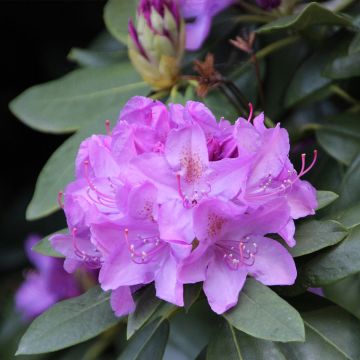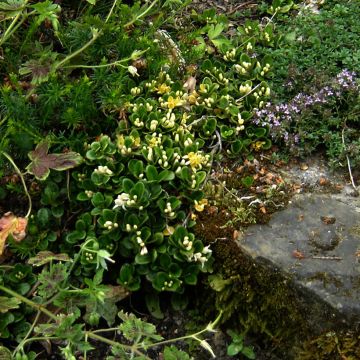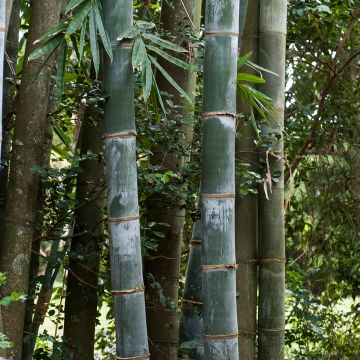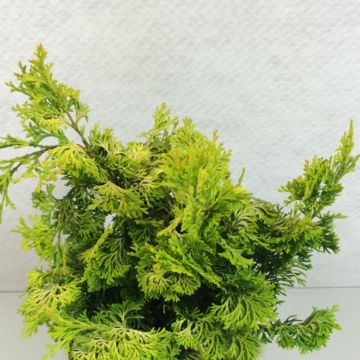

Rhododendron Lisetta
Rhododendron Lisetta
Rhododendron x haematodes Lisetta ® 'Hachlise'
Rhododendron hybride
I am very disappointed! It looks nothing like the photo, the leaves are in good condition but the buds are in a pitiful state, and the flowers as well... The bush must have spent a lot of time in a pot, given the quantity of roots that are very difficult to untangle... This is probably why this variety is now on sale at -20%... I, on the other hand, paid full price for it...
Gwen59, 14/04/2024
This item cannot be shipped to the selected country
Delivery charge from €5.90
More information
Schedule delivery date,
and select date in basket
This plant carries a 24 months recovery warranty
More information
We guarantee the quality of our plants for a full growing cycle, and will replace at our expense any plant that fails to recover under normal climatic and planting conditions.
From €5.90 for pickup delivery and €6.90 for home delivery
Express home delivery from €8.90.
Does this plant fit my garden?
Set up your Plantfit profile →
Description
The Rhododendron haematodes Lisetta is a dwarf bush with evergreen foliage, attractive with its beautiful red floral robe, unfailing during its 3-week flowering period in May. This variety, which blooms very abundantly, bears funnel-shaped flowers with fringed edges, of a pure and deep red. Its foliage is unique, quite large, dark green and shiny. Very hardy, it can be planted in any non-calcareous, humus-bearing and moist soil, in partial shade.
The Rhododendrons belong to the Ericaceae family, which blesses us with numerous ornamental plants (Erica, Enkianthus, Kalmia, Zenobia, Oxydendrum) as well as some fruit plants (Strawberry Tree, Blueberry). The genus Rhododendron is extremely vast, mainly comprising bushes, but also trees over 10m (33ft) high, generally evergreen but sometimes deciduous, especially among the Azaleas which are, botanically speaking, actually Rhododendrons. The Rhododendron haematodes Lisetta is the result of a cross-breeding between R. haematodes x R. repens. It forms a dense spreading bush, wider than tall, 70cm (28in) high and 1.10m (4ft) wide when fully grown. Its evergreen dark green leaves are elliptical in shape, slender and leathery with prominent veins. During the month of May, this dwarf bush is literally covered in pure red flowers. The flowers are grouped in tight terminal corymbs. A special moment in your garden.
Hardy up to -24°C (-11.2°F), the Rhododendron haematodes Lisetta enjoys a partial shade exposure. With slow growth, this acid-loving heathland bush thrives in cool, humus-bearing and well-drained soil. It can be used as a standalone or in mass plantings, at the edge of woodlands, in Japanese gardens, in borders, especially with other acid-loving plants. When combined with Kalmias, Azaleas, Pieris or other rhododendrons from the same group, it creates superb patchworks of textures and colours in spring. Growing it in a container requires regular watering with non-calcareous water and specific fertilization for acid-loving plants.
Report an error about the product description
Plant habit
Flowering
Foliage
Botanical data
Rhododendron
x haematodes
Lisetta ® 'Hachlise'
Ericaceae
Rhododendron hybride
Cultivar or hybrid
Other Small Rhododendron
Planting and care
Plant the Lisetta Rhododendron haematodes in a sunny or partially shaded position, protected from cold and drying winds, in a fresh, humus-rich and light soil with an acidic tendency. Like all plants of the heathland, it does not tolerate limestone soils or heavy soils that become waterlogged in winter. Dig a hole three times larger than the pot. Soak the root ball in non-limestone water and plant the bush at the level of the collar, in a mixture composed of 1/4 turf, leaf compost, gravel or pumice, and loam. Water generously and keep the soil moist in summer. Azaleas and Rhododendrons have a shallow root system. As a result, they are susceptible to long periods of drought. That is why it is recommended to enrich the soil with humus and provide abundant watering during dry periods. In addition, this root system is not very strong, so it is essential to lighten heavy soils with draining materials (gravel, pumice, clay pellets) at planting. Apply a mulch of shredded pine bark around the base of the bush every spring to retain soil moisture and maintain an acidic pH. Maintenance consists of removing faded flowers in summer and cleaning dead branches. Azaleas and Rhododendrons can sometimes be attacked by weevils that eat the edges of the leaves and rootlets, as well as the famous "Rhododendron beetle" which does not often cause severe damage. You can, however, treat them with carbofuran. Yellowing of the leaves (chlorosis) in Rhododendrons indicates poor assimilation of iron in the soil and leads to premature plant death. While limestone is often the cause, poorly drained soil or a deeply planted root ball may also explain the phenomenon.
Planting period
Intended location
Care
-
, onOrder confirmed
Reply from on Promesse de fleurs
Evergreen shrubs
Haven't found what you were looking for?
Hardiness is the lowest winter temperature a plant can endure without suffering serious damage or even dying. However, hardiness is affected by location (a sheltered area, such as a patio), protection (winter cover) and soil type (hardiness is improved by well-drained soil).

Photo Sharing Terms & Conditions
In order to encourage gardeners to interact and share their experiences, Promesse de fleurs offers various media enabling content to be uploaded onto its Site - in particular via the ‘Photo sharing’ module.
The User agrees to refrain from:
- Posting any content that is illegal, prejudicial, insulting, racist, inciteful to hatred, revisionist, contrary to public decency, that infringes on privacy or on the privacy rights of third parties, in particular the publicity rights of persons and goods, intellectual property rights, or the right to privacy.
- Submitting content on behalf of a third party;
- Impersonate the identity of a third party and/or publish any personal information about a third party;
In general, the User undertakes to refrain from any unethical behaviour.
All Content (in particular text, comments, files, images, photos, videos, creative works, etc.), which may be subject to property or intellectual property rights, image or other private rights, shall remain the property of the User, subject to the limited rights granted by the terms of the licence granted by Promesse de fleurs as stated below. Users are at liberty to publish or not to publish such Content on the Site, notably via the ‘Photo Sharing’ facility, and accept that this Content shall be made public and freely accessible, notably on the Internet.
Users further acknowledge, undertake to have ,and guarantee that they hold all necessary rights and permissions to publish such material on the Site, in particular with regard to the legislation in force pertaining to any privacy, property, intellectual property, image, or contractual rights, or rights of any other nature. By publishing such Content on the Site, Users acknowledge accepting full liability as publishers of the Content within the meaning of the law, and grant Promesse de fleurs, free of charge, an inclusive, worldwide licence for the said Content for the entire duration of its publication, including all reproduction, representation, up/downloading, displaying, performing, transmission, and storage rights.
Users also grant permission for their name to be linked to the Content and accept that this link may not always be made available.
By engaging in posting material, Users consent to their Content becoming automatically accessible on the Internet, in particular on other sites and/or blogs and/or web pages of the Promesse de fleurs site, including in particular social pages and the Promesse de fleurs catalogue.
Users may secure the removal of entrusted content free of charge by issuing a simple request via our contact form.
The flowering period indicated on our website applies to countries and regions located in USDA zone 8 (France, the United Kingdom, Ireland, the Netherlands, etc.)
It will vary according to where you live:
- In zones 9 to 10 (Italy, Spain, Greece, etc.), flowering will occur about 2 to 4 weeks earlier.
- In zones 6 to 7 (Germany, Poland, Slovenia, and lower mountainous regions), flowering will be delayed by 2 to 3 weeks.
- In zone 5 (Central Europe, Scandinavia), blooming will be delayed by 3 to 5 weeks.
In temperate climates, pruning of spring-flowering shrubs (forsythia, spireas, etc.) should be done just after flowering.
Pruning of summer-flowering shrubs (Indian Lilac, Perovskia, etc.) can be done in winter or spring.
In cold regions as well as with frost-sensitive plants, avoid pruning too early when severe frosts may still occur.
The planting period indicated on our website applies to countries and regions located in USDA zone 8 (France, United Kingdom, Ireland, Netherlands).
It will vary according to where you live:
- In Mediterranean zones (Marseille, Madrid, Milan, etc.), autumn and winter are the best planting periods.
- In continental zones (Strasbourg, Munich, Vienna, etc.), delay planting by 2 to 3 weeks in spring and bring it forward by 2 to 4 weeks in autumn.
- In mountainous regions (the Alps, Pyrenees, Carpathians, etc.), it is best to plant in late spring (May-June) or late summer (August-September).
The harvesting period indicated on our website applies to countries and regions in USDA zone 8 (France, England, Ireland, the Netherlands).
In colder areas (Scandinavia, Poland, Austria...) fruit and vegetable harvests are likely to be delayed by 3-4 weeks.
In warmer areas (Italy, Spain, Greece, etc.), harvesting will probably take place earlier, depending on weather conditions.
The sowing periods indicated on our website apply to countries and regions within USDA Zone 8 (France, UK, Ireland, Netherlands).
In colder areas (Scandinavia, Poland, Austria...), delay any outdoor sowing by 3-4 weeks, or sow under glass.
In warmer climes (Italy, Spain, Greece, etc.), bring outdoor sowing forward by a few weeks.























































